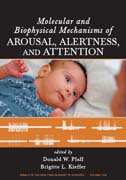
Molecular and biophysical mechanisms of arousal, alertness and attention
Pfaff, Donald W.
Brain mechanisms for arousal, alertness, and attention underlie all cognitivefunctions and all emotional expression. This volume discusses the neuroanatomy, neurophysiology, and functional genomics of these states, and the medical consequences of their damage in human patients. INDICE: Preface: Donald Pfaff and Brigitte L. Kieffer.Mechanisms for the Regulation of State Changes in the Central Nervous System: An Introduction: Donald W. Pfaff, Brigitte L. Kieffer, and Larry W. Swanson.Part I: Elementary Central Nervous System Arousal:.Mechanisms in the Animal Brain.1. Concepts and Mechanisms of Generalized Central Nervous System Arousal: Donald Pfaff, Ana Ribeiro, James Matthews, and Lee-Ming Kow.2. Modulation of Cortical Activation andBehavioral Arousal by Cholinergic and Orexinergic Systems: Barbara E. Jones.3. Dopamine Signaling in the Dorsal Striatum is Essential for Motivated Behaviors: Lessons from Dopamine-deficient Mice: Richard D. Palmiter.4. Ablation of the Central Noradrenergic Neurons for Unraveling Their Roles in Stress and Anxiety: Keiichi Itoi.Heightened States of Arousal: Sex and Fear.5. Neural Substrates for Sexual Preference and Motivation in the Female and Male Rat: Yasuo Sakuma.6. Motivational Influences on the Degree and Direction of Sexual Attraction: Marisela Hernández-González, Miguel Angel Guevara, and Anders Ågmo.7. Fear Conditioning and LTP in the Amygdala: What Really is the Connection?: P. Sah, R. F. Westbrook, and A. Lüthi.8. Insights into the Pharmacological Potential of Estrogens and Phytoestrogens on Catecholamine Signaling: Nobuyuki Yanagihara, Yumiko Toyohira, and Yuko Shinohara.Elementary Central Nervous System Arousal: Clinical Studies.9. Central Thalamic Contributions to Arousal Regulation and Neurological Disorders of Consciousness: Nicholas D. Schiff.10. Intrinsic Brain Activity in Altered States of Consciousness: How Conscious is the Default Mode of Brain Function?: M. Boly, C. Phillips, L. Tshibanda, A. Vanhaudenhuyse, M. Schabus, T.T. Dang-Vu, G. Moonen, R. Hustinx, P. Maquet, and S. Laureys.11. Detecting Awareness in the Vegetative State: Adrian M. Owen and Martin R. Coleman.Part II: The EmotionCognition Interface:.12. Neural Mechanisms Underlying Selective Attention to Threat: Sonia J Bishop.13. Toward a Neurogenetic Theory of Neuroticism: Turhan Canli.14. Gene Expression is Altered in the LateralHypothalamus upon Activation of the Mu Opioid Receptor: K. Befort, D. Filliol, E. Darcq, A. Ghate, A. Matifas, A. Lardenois, J. Muller, C. Thibault, D. Dembele, O. Poch, and B.L. Kieffer.15. Bipolar Disorder as Maladaptive Arousal: ABehavioral Model and Evidence: Dean F. MacKinnon.Part III: Alertness and Attention:.Underlying Mechanisms.16. Measuring Alertness: Michael I. Posner.17. Molecular Genetics of Attention: Mark A. Bellgrove and Jason B. Mattingley.18. Anatomical Basis for the Attentional Modulation of Hippocampal Neurons: David C. Rowland and Clifford G. Kentros.19. Cholinergic Mediation of Attention: Contributions of Phasic and Tonic Increases in Prefrontal Cholinergic Activity: Vinay Parikh and Martin Sarter.Attention Deficit Disorders.20. Neuronal Mechanisms Underlying Attention Deficit Hyperactivity Disorder: The Influence of Arousal on Prefrontal Cortical Function: Avis R. Brennan and Amy F.T. Arnsten.21. Placing Neuroanatomical Models of Executive Function in a Developmental Context: Imaging and Imaging-genetic Strategies: Karin Brocki, Jin Fan, and John Fossella.22. Functional Gene Variation in the Human Norepinephrine Transporter: Association with Attention Deficit/Hyperactivity Disorder: Chun-Hyung Kim, IrwinD. Waldman, Randy D. Blakely, and Kwang-Soo Kim.Part IV: Circadian Rhythms inthe Activation of Behavior:.Physiologic Mechanisms of Arousal and Sleep.23. Circadian and Homeostatic Factors in Arousal: Rae Silver and Joseph LeSauter.24. Hypothalamic Regulation of Sleep and Arousal: Ronald Szymusiak and Dennis McGinty.25. Associations between Sleep Loss and Increased Risk of Obesity and Diabetes: Kristen L. Knutson and Eve Van Cauter.26. Sleep Deprivation and Vigilant Attention: Julian Lim and David F. Dinges..Genomics of Sleep and BiologicalClocks.27. Sleep and Wakefulness in Drosophila melanogaster: Chiara Cirelli and Daniel Bushey.28. Why does Consciousness Fade in Early Sleep?: Giulio Tononi and Marcello Massimini.29. Molecular Mechanisms of Sleep and Wakefulness: Miroslaw Mackiewicz, Nirinjini Naidoo, John E. Zimmerman, and Allan I. Pack.30. The In(put)s and Out(put)s of the Drosophila Circadian Clock: Catharine E. Boothroyd and Michael W. Young.31. Peripheral Circadian Oscillators: Interesting Mechanisms and Powerful Tools: Ludmila Cuninkova and Steven A. Brown
- ISBN: 978-1-57331-703-0
- Editorial: New York Academy of Science
- Encuadernacion: Rústica
- Páginas: 400
- Fecha Publicación: 28/07/2008
- Nº Volúmenes: 1
- Idioma: Inglés
